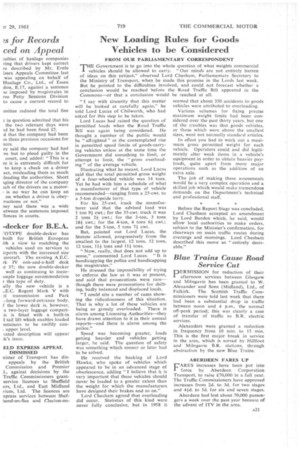New Loading Rules for Goods Vehicles to be Considered
Page 23

If you've noticed an error in this article please click here to report it so we can fix it.
FROM OUR PARLIAMENTARY CORRESPONDENT "THE Government is to go into the whole question of what weights commercial I vehicles should be allowed to carry. "Our minds are not entirely barren of ideas on this subject," observed Lord Chesham, Parliamentary Secretary to the Ministry of Transport, when he made this promise in the Lords last week. But he pointed to the difficulties involved, and could not forecast whether a conclusion would be reached before the Road Traffic Bill appeared in the Commons—or that a conclusion would be reached at all.
" I say with sincerity that this matter will be looked at carefully again," he told Lord Lucas of Chilworth, who had asked for this step to be taken.
Lord Lucas had raised the question of permitted loads when the Road Traffic Bill was again being considered. He thought a number of the public would be " affrighted " at the contemplated rise in permitted speed limits of goods-carrying vehicles unless at the same time the Government did something to limit, or attempt to limit, the "gross overloading" of the average vehicle.
Illustrating what he meant, Lord Lucas said that the total permitted gross weight of a four-wheeled vehicle was 14 tons. Yet he had with him a schedule of what a manufacturer of that type of vehicle recommended—ranging from a 25-cwt. to a 5-ton dropside lorry.
For his 25-cwt. truck the manufacturer said that the advised load was 1 ton 91 cwt.; for the 35-cwt. truck it was 2 tons 2+ cwt.; for the 3-ton, 3 tons 18+ cwt.; for the 4-ton, 4 tons 6+ cwt.; and for the 5-ton, 5 tons 7+ cwt.
But, pointed out Lord Lucas, the Statute allowed, progressively from the smallest to the largest. 12 tons, 12 tons, 12 tons, lI tons and 11+ tons.
"Now, really, that does not add up to sense," commented Lord Lucas. "It is handicapping the police and handicapping the magistrates."
He stressed the impossibility of trying to enforce the law as it was at present, and said that prosecutions were rare— though there were prosecutions for shifting, badly balanced and displaced loads.
"I could cite a number of cases showing the ridiculousness of this situation. That is why a lot of these vehicles are being so grossly overloaded. There is alarm among Licensing Authorities—they have drawn attention to it in their annual reports—and there is alarm among the police."
Speed was becoming greater, loads getting heavier and vehicles getting larger, he said. The question of safety was something which sooner or later had to be solved.
He received the backing of Lord Hawke, who spoke of vehicles which appeared to be in an advanced stage of obsolescence, adding "I believe that it is very important that these vehicles should never be loaded to a greater extent than the weight for which the manufacturers have designed their brakes and so on."
Lord Chesham agreed that overloading did occur. Statistics of this kind were never fully conclusive, but in 1958 it seemed that about 350 accidents to goods vehicles were attributethto overloading.
Various schemes for fixing precise maximum weight limits had been considered over the past thirty years, but one of the troubles was that goods vehicles, or those which were above the smallest sizes, were not normally standard articles.
In effect you had to work out a maximum gross permitted weight for each vehicle. Operators could and did legitimately alter weak items in a vehicle's equipment in order to obtain heavier payloads, quite apart from more major operations such as the addition of an extra axle.
The job of making these assessments would be a very complex operation and a skilled job which would make tremendous demands on the Department's technical and professional staff.
Before the Report Stage was concluded, Lord Chesham accepted an amendment by Lord Burden which, he said, would allow local authorities to make orders, subject to the Minister's confirmation, for clearways on main traffic routes during evenings and mornings. Lord Chesham described this move as "entirely desirable."
Blue Trains Cause Road Service Cut
ID ERMISSION for reduction of their 1 afternoon services between Glasgow and Milngavie has been granted to W. Alexander and Sons (Midland), Ltd., of Falkirk. The Scottish Traffic Commissioners were told last week that there had been a substantial drop in traffic between noon and 4 p.m., the normal off-peak period; this was clearly a case of transfer of traffic to B.R. electric services.
Alexanders were granted a reduction in frequency from 10 mm. to 15 min. This is the first major break in service in the area, which is served by Hillfoot and Milngavie B.R. stations, through abstraction by the new Blue Trains.
ABERDEEN FARES UP
FARES increases have been put into force by Aberdeen Corporation Transport, to raise £70,000 in a full year. The Traffic Commissioners have approved increases from 2d. to 3d. for two stages and 4+d. to 5d. for six and seven stages.
Aberdeen had lost about 70,000 passengers a week over the past year because of the advent of ITV in the area.




























































































